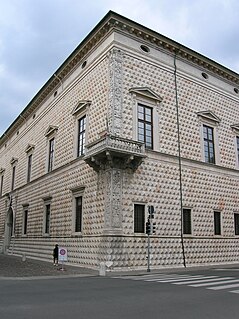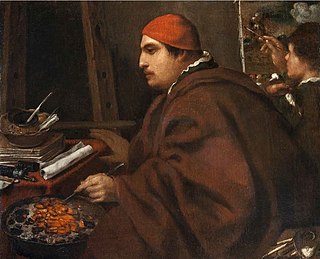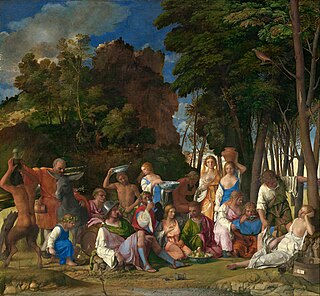
Dosso Dossi was an Italian Renaissance painter who belonged to the School of Ferrara, painting in a style mainly influenced by Venetian painting, in particular Giorgione and early Titian.

Girolamo Da Carpi was an Italian painter and decorator who worked at the Court of the House of Este in Ferrara. He began painting in Ferrara, by report apprenticing to Benvenuto Tisi ; but by age 20, he had moved to Bologna, and is considered a figure of Early Renaissance painting of the local Bolognese School.

Benvenuto Tisi was a Late-Renaissance-Mannerist Italian painter of the School of Ferrara. Garofalo's career began attached to the court of the Duke d'Este. His early works have been described as "idyllic", but they often conform to the elaborate conceits favored by the artistically refined Ferrarese court. His nickname, Garofalo, may derive from his habit of signing some works with a picture of a carnation.

Lorenzo Costa was an Italian painter of the Renaissance.
The School of Ferrara was a group of painters which flourished in the Duchy of Ferrara during the Renaissance. Ferrara was ruled by the Este family, well known for its patronage of the arts. Patronage was extended with the ascent of Ercole d'Este I in 1470, and the family continued in power till Alfonso II, Ercole's great-grandson, died without an heir in 1597. The duchy was then occupied in succession by Papal and Austrian forces. The school evolved styles of painting that appeared to blend influences from Mantua, Venice, Lombardy, Bologna, and Florence.
Ludovico Mazzolino - also known as Mazzolini da Ferrara, Lodovico Ferraresa, and Il Ferrarese - was an Italian Renaissance painter active in Ferrara and Bologna.
Sebastiano Filippi was an Italian late Renaissance – Mannerist painter of the School of Ferrara.

Ortolano was an Italian painter of the Ferrara School, active in the Renaissance period. Ticozzi cites his birth as ca. 1480.

Palazzo dei Diamanti is a Renaissance palace located on Corso Ercole I d'Este 21 in Ferrara, region of Emilia Romagna, Italy. The main floor of the Palace houses the Pinacoteca Nazionale di Ferrara.

Giuseppe Mazzuoli was an Italian painter of the Mannerist period, active mainly in the court of Alfonso II d'Este of Ferrara.

Giuseppe Caletti or Calletti was an Italian painter and engraver of the Baroque period, active in Ferrara and Cremona. He often painted religious themes in a genre like dress and surroundings, including the theme of Bacchanalia like Titian.

Giovanni Francesco Surchi was an Italian painter of the late-Renaissance period, active in Ferrara.

The Feast of the Gods is an oil painting by the Italian Renaissance master Giovanni Bellini, with substantial additions in stages to the left and center landscape by Dosso Dossi and Titian. It is one of the few mythological pictures by the Venetian artist. Completed in 1514, it was his last major work. It is now in the National Gallery of Art in Washington D.C., which calls it "one of the greatest Renaissance paintings in the United States".
Battista Dossi, also known as Battista de Luteri, was an Italian painter who belonged to the Ferrara School of Painting. He spent nearly his entire career in service of the Court of Ferrara, where he worked with his older brother Dosso Dossi. It is believed that Battista worked in the Rome studio of Raphael from 1517 to 1520. Battista's students include Camillo Filippi.
Gianfranco Goberti is an Italian painter. After studying Arts at the Institut Dosso Dossi in Ferrara, Italy, and at the Academy of Art in Bologna, he was teacher and Director of the Institut of Arts Dosso Dossi. His first exhibition was held in 1959 with references to Picasso and Bacon. His research dealt with nuova figurazione and Abstract Expressionism. The first optical-figurative period starts during the 1960s. In 1980, he was selected by the National Catalogue of Modern Art Bolaffi together with Paolini, Adami, Bulgarelli, Cassano and Paladino. Goberti has held exhibitions at the International Art Expo of Bilbao, Quadriennale d'Arte in Rome, Rassegna Premio S. Fedele (Milan), Arte Fiera (Bologna), Altissima (Turin), Expo Arte (Bari), ArteExpo (Barcelona), and LineArt (Ghent), "La Venere svelata – La Venere di Urbino di Tiziano".
Events from the year 1542 in art.

The Camerini d'alabastro are a range of rooms built over the Via Coperta in Ferrara, northern Italy, linking the Castello Estense to the Palazzo Ducale. They may have included the studiolo or little study of Alfonso I d'Este, Duke of Ferrara.

Camillo Filippi was an Italian painter who flourished about the middle of the 16th century.

The Reign of Comus is a Renaissance painting painted by Lorenzo Costa for the Studiolo of Isabella d'Este at the Ducal Palace in Mantua. The painting is now in the Louvre in Paris.

The Pinacotecta Nazionale is an art gallery in Ferrara, Emilia-Romagna, Italy. It is located on the piano nobile of the Palazzo dei Diamanti, a work of Renaissance architecture by Biagio Rossetti, commissioned by Leonello d’Este in 1447. Not to be confused with the Civic Museum on the lower floor, which has hosted temporary exhibitions of contemporary art since 1992, the Pinacoteca houses a collection of paintings by the Ferrarese School dating from the thirteenth to the eighteenth centuries. It was founded in 1836 by the Municipality of Ferrara after Napoleon's widespread dissolution of churches threatened the protection of important public artworks. The gallery is formed as much around notable northern Italian painters as it is around the exquisite interior decoration of the palace itself, together with remnants of frescoes from local churches and later acquisitions from the Sacrati Strozzi collection.














